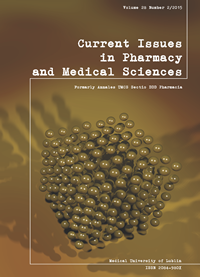The inflluence of emulsifiers on physical properties and release parameters of creams with caffeine
DOI:
https://doi.org/10.1515/cipms-2015-0049Keywords:
caffeine release, creams, emulsifiers, rheologyAbstract
Caffeine is well known alkaloid chemical compound belonging to the methyl-xanthines group. It is an active substance that is found in many cosmetic products, as it has a stimulating action on both the central nervous system and the metabolism. Commercially available topical formulations normally contain 3% of caffeine and 7% anticellulite products.
The aim of our work was to investigate the properties of four cream preparations. These consisted of 5% of caffeine and one of four different emulsifiers (GSC, Sodium polyacrylate, Emulsifying Base, MDS). In our work, we compared the physical properties (spreadability, slip and tenacity), the rheological structure of the resulting creams and the caffeine release from the obtained preparations. The results showed that the properties of these creams and their drug release depended upon the kind of the emulsifiers utilised. What is more, all preparations have a pseudoplastic character of flow and most of them have significant thixotropy. Furthermore, the amount of released caffeine is the largest from the MDS cream, and this emulsifier seems to be the most optimal in all the examined items.
References
1. Achim M. et al.: Topical dosage forms containing fluid-extract of ruscus aculeatus: Formulation, preparation and physical characterization. Clujul Medical. 83, 99-103, 2010.
2. Ballman C., Mueller B.: Stabilizing effect of cetostearyl alcohol and glyceryl monostearate as co-emulsifiers on hydrocarbon-free o/w glyceride creams. Pharm. Dev. Technol., 13, 433-445, 2008.
3. Barel A., Paye M., Maibach H.: Handbook of Cosmetic Science and Technology. Informa Health Care, New York, 2009.
4. Bottari F.: Influence of drug concentration on in vitro release of salicylic acid from ointment bases. J. Pharm. Sci., 63, 1979-1983, 1974.
5. Davis M.G. et al.: A novel cosmetic approach to treat thinning hair. Brit.J.Derm.,65, 24-30, 2011.
6. Erös I., Thaleb A.: Rheological studies of creams. I. Rheological functions and structure of creams. Acta Pharm. Hung., 64, 101-103, 1994.
7. Erös I., Thaleb A.: Rheological studies of creams. II. Effect of water content on rheological characteristics. Acta Pharm. Hung., 66, 71-76, 1996.
8. Erös I., Thaleb A.: Rheological studies of creams. III. Effect of lipophilic phase on consistency. Acta Pharm. Hung., 66, 77-81, 1996.
9. Fiebig A., Janicki St., Sznitowska M.: Farmacja stosowana. PZWL, Warszawa, 2004.
10. Fischer T.W.,Hipler U.C., Elsner P.: Effect of caffeine and testosterone on the proliferation of human hair follicles in vitro. Int. J. Derm., 46, 27-35, 2007.
11. Krówczyński L.: Technologia postaci leków. PZWL, Warszawa, 1969.
12. Otberg N. et al.: The role of hair follicles in the percutaneous absorption of caffeine. Br. J. Clin. Pharmacol., 65, 488-492, 2008.
13. Polish Pharmacopea IX, Urząd Rejestracji Produktów Leczniczych, Wyrobów Medycznych I Produktów Bójczych, Warszawa, 2011.
14. Provost C., Kinget R., Herbots H.: The influence of emulsifiers on drug diffusion from o/w cream. Pharm. Weekbl. Sci., 18, 248-251, 1981.
15. Roure R. et al.: Evaluation of the efficacy of a topical cosmetic slimming product combining tetrahydroxypropyl ethylenediamine, caffeine, carnitine, forskolin and retinol, in vitro, ex vivo and in vivo studies. Int. J. Cosm. Sci., 33, 519-526, 2011.
16. Sainio E., Rantanen T.,Kanerva L.: Ingredients and safety of cellulite creams. Eur. J. Dermatol., 10, 596-603, 2000.
17. Vogelgesang B. et al.: In vitro and in vivo efficacy of sulfo-carrabiose, a sugar-based cosmetic ingredient with anti-cellulite properties. Int. J. Cosm. Sci., 33, 120-125, 2011.
18. Wilkinson S.C. et al.: Interactions of skin thickness and physiochemical properties of test compounds in percutaneous penetration studies. Int. Archiv. Occup. Envir Health., 79, 05-413, 2006.
19. Wojciechowska K. et al.: Physical properties and caffeine release from creams prepared with different oils. Curr. Issues Pharm. Med. Sci., 27, 224-228, 2014.
Downloads
Published
Issue
Section
License
Copyright (c) 2015 Authors

This work is licensed under a Creative Commons Attribution-NonCommercial-NoDerivatives 3.0 Unported License.


